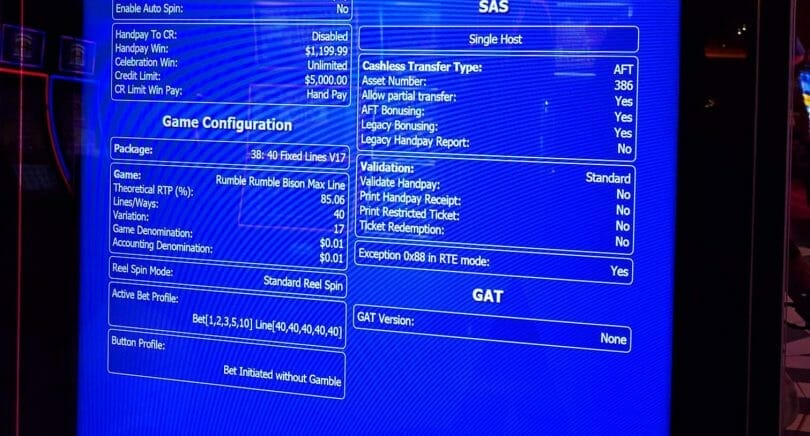The more mathematically inclined among us find slot machine math interesting, and aim to know a bit more about how it all works. In today’s post I’m going to talk about two statistics that provide similar info, but take different factors into account: Return to Player (RTP) and Weighted Average Theoretical Payback (WATP).
Both Calculations Give the Same Info
Both calculations are used for different purposes, but they’re designed to provide the same basic understanding: What percentage of wagers, over time, are theoretically expected to be paid to the player in the form of winnings on wagers. Slot machines are generally programmed to have many thousands (or even millions) of outcomes, and over millions of spins the expected outcomes will slowly converge on this statistic.
The reason there’s two statistics giving the same basic info is simply because machines can be in two forms – a single game machine with one payback setting, where the payback is set to payback on all options, or a machine with multiple games (or one game with multiple denominations), where the payback may not be consistent across all choices.
Return to Player (RTP): A Single Outcome Source
For simpler scenarios, Return to Player (sometimes seen as Theoretical RTP) does the trick. It is the expected payback of the game over time. The game is set based on the options provided by the manufacturer, and it’s one setting that governs the game.
Simpler games, like one denomination with a few bet levels, are almost universally like this. There’s no real calculations to do because the game is simply programmed to pay out at a certain level based on the total number of outcome possibilities and what each pays.
Weighted Average Theoretical Percentage (WATP): More Complex
WATP, on the other hand, is needed when you have multiple games, multiple denominations set differently, and other scenarios where games don’t have consistent, identical paybacks.
Imagine a video poker machine with eight game types, each which pay a bit differently. Each game will have its own RTP number, the games will be played at different amounts. So the machine won’t have one RTP governing everything going on inside, and it can’t possible guarantee that if players play a higher paying game more often than a lower paying one.
This same logic can work for multi-game cabinets that feature different slot games with different payouts. This can also hold true for a slot that houses a single game, but different denominations that payback at different levels, which is increasingly common on modern slot machines and gaming floors.
So that’s where WATP comes in. It builds a blended average, based on the actual coin-in and the RTP of each game played. Let’s take this scenario using some simple numbers. Let’s assume a machine has two games:
- Game A has a 90% RTP
- Game B has a 91% RTP
Let’s say $1,000 in bets were made on this machine.
- 25%, or $250, was made on Game A
- 75%, or $750, was made on Game B
The WATP would be 90.75%, because more coin-in was made on Game B than A, and therefore the expected return to player would be higher than Game A and lower than Game B. The calculation would look as follows:
(.9*.25)+(.91*.75)=.9075 (90.75%)
The more games and more complex coin-in scenarios, the more complex the formula, but the same basic idea governs it. This helps casinos better understand how the blend of games should pay out, and how the actual payouts are going compared to it.
You can also calculate it by figuring out the theoretical payback of each game based on the coin-in, and then do the math to divide the theoretical over the total coin-in:
- Game A would theoretically pay back $225
- Game B would theoretically payback $682.50
- Their sum is $907.50
- $907.50/$1000 is .9075, or 90.75%
WATP was a new term to me but once you realize why it exists it makes proper sense. To learn more about some casino math in terms of basic payout terms and calculations, check out this great article by Sheryl L. Ashley on the subject.









QUESTION HERE is what are the ods of a specified machine paying out in a 4 hour session
Hi there – that’s an impossible question to answer as every game has its own parameters. Also, most games are designed to reach their expected payback over hundreds of thousands of spins… and most of us spin 400-600 spins an hour. So you’re talking hundreds or thousands of hours of play to reach that norm, and even a four-hour session can vary widely because of that.
What is the difference between “won” and “Paid” on the slot display?
Hi Rick – I originally had posted that “won” would likely relate to the credits on screen, while “paid” would relate to the ticket earned, but I paid a bit closer attention on my latest casino visit given your question and found the words being used interchangeably on games, so I’m not sure there is any formal difference.
Can you please explain how RNGs are programmed for a specific RTP. I couldn’t understand how it is possible to set a specific RTP with RNGs pure randomness.
Hi Doni! I will be doing a more complete post on this soon, but the key variable many forget is that the RTP is random within a range of outcomes. It can’t do anything it want – if a game is designed with a top prize of $1,000, it can’t pay $1 million. So it randomly is working with a set number of outcomes, and that set number of outcomes rolls up to the game’s expected return to player (RTP). Hope this helps!